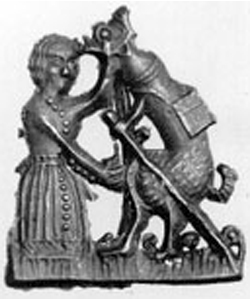Badges
 Late medieval badges are small, cheap, popular ornaments dating from the late twelfth to the middle of the sixteenth century. The last 30 years, thousands of badges were found with the help of metal detectors, in the Netherlands and Flanders. Most badges were cast from molds, using an easily processed lead-tin alloy. They were manufactured and sold in large quantities, and distributed among all classes of the population. Due to their great variation in themes, these badges give us an unique insight in the late medieval folk culture.
Late medieval badges are small, cheap, popular ornaments dating from the late twelfth to the middle of the sixteenth century. The last 30 years, thousands of badges were found with the help of metal detectors, in the Netherlands and Flanders. Most badges were cast from molds, using an easily processed lead-tin alloy. They were manufactured and sold in large quantities, and distributed among all classes of the population. Due to their great variation in themes, these badges give us an unique insight in the late medieval folk culture.
Badges were worn - either pinned to, or sewn on, hats, coats or packs - as ornament but always with a specific meaning: as lovetokens, as symbols of piety, or the exact opposite. They could also indicate to which brotherhood or political party the wearer belonged, and they were sold as souvenirs on feastdays. It is well known that there must have been millions of pilgrims' badges. Pilgrims bought them as souvenirs of the places of pilgrimage they visited, or on church feastdays. The sale of profane or non-religious (and erotic) badges must have taken place in the same commercial manner. Itinerant pedlars and storytellers sold them on markets or fairs; wherever large groups of people gathered.
An iconographic data bank of the late middle ages
The wealth of representation on the pins is overwhelming, the themes inexhaustible. It is possible to range them from the purely devotional to the extremely pornographic; from Mary, Christ and the Holy Pilgrim James of Compostella, through many known and unknown saints and martyrs, kings, knights, musicians, millers and lovers, weapons, domestic objects, animals and independently operating phalli and vulvas, to intriguing jokes on the subject of pilgrimages, such as the pilgrim dressed as a phallus crowned by a woman and the vulva dressed up as a pilgrim. The late medieval badge is a fascinating visual source, not only for archaeologists and art historians, but also for researchers from other disciplines. It affords an unique insight into the iconographic culture of the late middle ages.
For an overview of the most significant badges click here.
 Late medieval badges are small, cheap, popular ornaments dating from the late twelfth to the middle of the sixteenth century. The last 30 years, thousands of badges were found with the help of metal detectors, in the Netherlands and Flanders. Most badges were cast from molds, using an easily processed lead-tin alloy. They were manufactured and sold in large quantities, and distributed among all classes of the population. Due to their great variation in themes, these badges give us an unique insight in the late medieval folk culture.
Late medieval badges are small, cheap, popular ornaments dating from the late twelfth to the middle of the sixteenth century. The last 30 years, thousands of badges were found with the help of metal detectors, in the Netherlands and Flanders. Most badges were cast from molds, using an easily processed lead-tin alloy. They were manufactured and sold in large quantities, and distributed among all classes of the population. Due to their great variation in themes, these badges give us an unique insight in the late medieval folk culture.